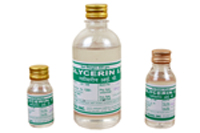|

Both glycerine and gelatine can be spelt with or without an e at the end. Glycerine is also known as glycerol and is labelled as E422. It can be of animal or non-animal origin, or a mixture of the two (making it animal in origin). In its chemical form, it cannot be tested to know its origin.
The dictionary definition of glycerine is a colourless, odourless, syrupy, sweet liquid C3H8O3 usually obtained by the saponification of natural fats and oils.
The two main raw materials to make soap are animal fat/tallow or vegetable oil (usually coconut or palm oil), and alkali or caustic soda/potash. In saponification, the tallow/oil which is chemically neutral splits into fatty acids which react with the alkali to form soap and glycerine. If tallow has been utilised, both the soap and the glycerine will be of animal origin, but not so if no animal ingredients have been used.
Tallow is not allowed to be used for making toilet soap in India so the glycerine marketed by soap manufacturers who use vegetable oils is presumably veg unless some other animal ingredients have been used, e.g. fragrance. However, if fatty acids are used in place of tallow or oil, then no glycerine will be produced during soap manufacture.
Stearic and oleic acids are usually fatty acids derived from tallow. Sodium tallowate is caustic soda plus tallow, and sodium palmate is caustic soda plus palm oil.
Glycerine is also a by-product of bio-diesel production and this method of producing crude glycerine is increasing. (Bio-diesel is produced from vegetable oil, animal fat/tallow, fish oil/wastes, or used cooking oil.) Crude glycerine is refined for use as an ingredient by the pharmaceutical, cosmetic and food companies as lubricants or humectants.
Glycerine can also be synthesized from propylene (fossil fuels – petroleum and natural gas) or produced by the bacterial fermentation of sugars.
India imports refined glycerine almost all of which is probably derived from palm kernel oil since it comes from Indonesia, Malaysia and the Philippines. India also exports refined glycerine to Nepal, Australia, Japan, Iran, France, UAE, Congo and Oman.
Uses
Glyceine is mainly used for sweetening and preserving food, in the manufacture of cosmetics, perfumes, inks, certain glues and cements, in solvents and automobile antifreeze, and in medicine like suppositories and skin emollients.
Innumerable pharmaceutical preparations such as tinctures, elixirs, cough medicines and anaesthetics contain it. It also is a basic medium for most tooth pastes.
In foods, it is an important moistening agent for baked goods and is added to candies and icings to prevent crystallisation. It is used as a solvent for food colours.
It is sprayed on tobacco before it is processed to prevent crumbling and is added to adhesives and glues to keep them from drying too fast.
Many specialised lubrication problems have been solved by using glycerine or glycerine mixtures.
As much as 15% is added to cellophane to render it pliable.
Sheets and gaskets made from ground cork are plasticized with glycerine.
Substitutes
Glycerine can be effectively substituted with the following substances of plant origin:
Shea butter extracted from the nut of the shea tree.
Jojoba oil produced from the seed of the jojoba plant. (Jojoba is pronounced ho-ho-ba.) This oil also replaces oil derived from the sperm whale.
Cocoa butter/theobroma oil obtained upon heating cocoa beans.
Avocado oil derived by pressing avocado fruit.
|